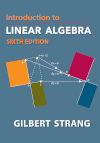- About MAA
- Membership
- MAA Publications
- Periodicals
- Blogs
- MAA Book Series
- MAA Press (an imprint of the AMS)
- MAA Notes
- MAA Reviews
- Mathematical Communication
- Information for Libraries
- Author Resources
- Advertise with MAA
- Meetings
- Competitions
- Programs
- Communities
- MAA Sections
- SIGMAA
- MAA Connect
- Students
- MAA Awards
- Awards Booklets
- Writing Awards
- Teaching Awards
- Service Awards
- Research Awards
- Lecture Awards
- Putnam Competition Individual and Team Winners
- D. E. Shaw Group AMC 8 Awards & Certificates
- Maryam Mirzakhani AMC 10 A Awards & Certificates
- Two Sigma AMC 10 B Awards & Certificates
- Jane Street AMC 12 A Awards & Certificates
- Akamai AMC 12 B Awards & Certificates
- High School Teachers
- News
You are here
Introduction to Linear Algebra

Buy Now:
Publisher:
Wellesley-Cambridge Press
Publication Date:
2023
Number of Pages:
440
Format:
Hardcover
Edition:
6
Price:
87.50
ISBN:
978-1-7331466-7-8
Category:
Textbook
The Basic Library List Committee recommends this book for acquisition by undergraduate mathematics libraries.
[Reviewed by , on ]
Allen Stenger
04/16/2023
Also see our review of the Fifth Edition. This Sixth Edition is an incremental update, but it doesn’t look that way at first glance (more about this later). The main differences are that the starting point has changed, from systems of linear equations in the Fifth Edition to “early vector spaces” in the Sixth Edition, and the applications are all different. The old applications are still available on the book’s web site. The exercises appear to be almost identical, except that a lot of the Worked Examples and Challenge Problems have been omitted.
New for this edition are chapters on optimization and on learning from data. The optimization chapter covers several techniques in a concise but reasonably-detailed manner: maxima and minima of multivariable functions using gradients, optimization with constraints (Lagrange multipliers), and linear programming. The learning from data chapter is about topics that are active research areas, and I thought there was just enough information to get the reader interested in these subjects without (unlike the optimization chapter) giving enough tools to do something useful. The topics are neural networks and piecewise linear modeling. There is also a more traditional section on probability mean, and variance.
The Sixth Edition is no longer in color, which is unfortunate. I think color in textbooks has been a hit or miss affair, but I thought the Fifth Edition did an excellent job of using blue highlights to bring out the most important facts and formulas on each page. One of my favorite sentences in mathematics writing has disappeared: “It is no exaggeration to say that symmetric matrices \( S \) are the most important matrices the world will ever see” (p. 338). This has been replaced in the Sixth Edition with the bland “Symmetric matrices \( S=S^{T} \) deserve all the attention they get.” (p. 246) Strang has a lively style that lets his enthusiasm for the subject show, and I was sorry to see this sentence go.
Now about why this may not seem an incremental update: The missing link is Strang’s 2020 book Linear Algebra for Everyone Let’s call that book LAFE, and the present book and its predecessor ILA6 and ILA5. As it turns out, LAFE was a preview for the new ILA6. ILA6 replaces Chapters 1–7 of ILA5 with Chapters 1–7 of LAFE (they are incorporated almost unchanged). The last half of ILA6 is mostly new material; it retains Chapter 8 (Linear Transformations) largely unchanged but replaces the remainder of the book with new applications. It also omits the Numerical Linear Algebra chapter. The net result is that ILA6 is about 150 pages shorter than ILA5. This is partly because the replacement applications are not as long, and partly because many Worked Examples and Challenge Problems have been eliminated.
Bottom line: The Sixth Edition is still an excellent choice as a text. For most one-semester courses you would not get past the first seven chapters, which are almost identical in Linear Algebra for Everyone, so that book would also be an excellent choice; it is about 100 pages shorter but the same list price.
Allen Stenger is a math hobbyist and retired software developer. He was Number Theory Editor of the Missouri Journal of Mathematical Sciences from 2010 through 2021. His personal website is allenstenger.com. His mathematical interests are number theory and classical analysis.
See the publisher's website.
- Log in to post comments




